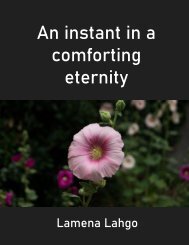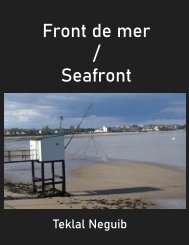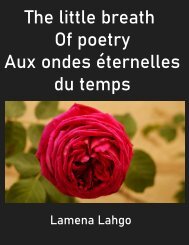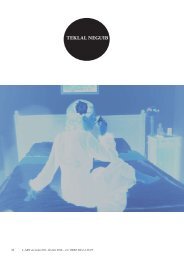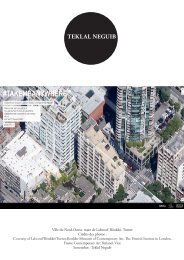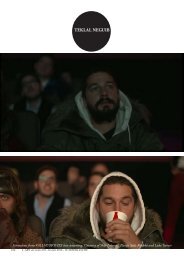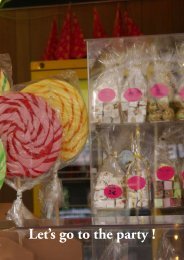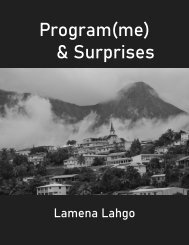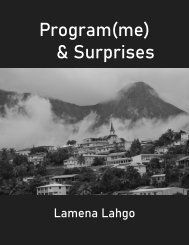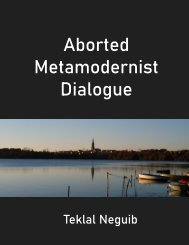Conversation with the visual artist Diango Hernandez
An interview i made as the EIC of L.ARTenLoire of the visual art artist Diango Hernandez, a cuban living in Germany. I fall in live with his waves series. Discover him ! A interview i made for the mag in 2015. #CARTEBLANCHE
An interview i made as the EIC of L.ARTenLoire of the visual art artist Diango Hernandez, a cuban living in Germany.
I fall in live with his waves series.
Discover him !
A interview i made for the mag in 2015.
#CARTEBLANCHE
You also want an ePaper? Increase the reach of your titles
YUMPU automatically turns print PDFs into web optimized ePapers that Google loves.
INTERVIEW PAR
TEKLAL
NEGUIB
D I A N G O
HERNANDEZ
Diango Hernández, Mountain of Dark, 2013. Graphite, glass
and wood
, 180 × 80 × 120 cm.
© the artist, Courtesy Marlborough Contemporary. Photo: Francis Ware.
108
L.ART en LOIRE - # 9 - juin 2015 - #CARTE BLANCHE
Diango Hernández, The New Man and the New Woman,
Marlborough Contemporary, London, 2013.
Exhibition view, Courtesy Marlborough Contemporary. Photo: Francis Ware.
Diango Hernández, Fascist Cultural Centre, 2013.
Wood, cheese, glass and offset printed paper, 170 × 80 × 100 cm.
© the artist, Courtesy Marlborough Contemporary. Photo: Francis Ware.
Diango Hernandez, qui es-tu ?
Comment te définirais-tu ?
Je suis un artiste visuel. Je suis né à Cuba en 1970 et je vis
et travaille actuellement en Allemagne. Je me considère
comme un explorateur, et à la manière de Jacques-Yves
Cousteau ou de Roald Amundsen, j’aime mes explorations
esthétiques et mes voyages à travers l’histoire de l’art.
Quel est le sujet/ l’objet de ta pratique artistique ?
Quel type d’art pratiques-tu ?
Depuis le jour où j’ai commencé à penser à l’art, et plus tard
lorsque j’ai commencé à en faire, je suis parti du principe que
l’art était une aventure. Depuis lors, l’art est un défi que je
relève dans toutes ses possibilités. Ma pratique artistique est
guidée depuis le commencement par les observations que
j’ai faites des endroits où j’ai choisi de voyager et de vivre.
Une grande part de mes réflexions et créations viennent
des années où je vivais à Cuba. Mon œuvre entière est
souvent vue comme se situant dans la tradidion de l’art
conceptuel, bien que je me sente proche des définitions
d’autres types d’arts, telles que la “vérité poétique” (“poetic
truth”) de W.G. Sebald 1 .
Peux-tu présenter ton exposition Eugène (Eugene)
qui semble si intéressante ? Qui est/était Eugène ?
pourquoi l’avoir choisi comme sujet d’exposition ?
Eugène est probablement la plus complexe de toutes les “ articulations
” que j’ai créée à ce jour. Quand je dis complexe, je
veux dire, que même moi, je me suis perdu dans le “ tissage ”
de l’œuvre. D’une part, Eugène est un hommage à Eugène
von Gundlach 2 , un personnage de fiction que j’ai créé en
2013 pour l’exposition Nature Socialiste (Socialist Nature) et
d’autre part Eugène traite de cette aventure qu’est grandir.
Notre échelle humaine, l’échelle du monde qui nous entoure,
et le voyage de va-et-vient entre ses différentes
échelles sont la clé de la composition de cette exposition.
Peut-être que la meilleure façon de comprendre Eugène est
de visualiser un cœur en mouvement, le cœur qui se contracte
(systole) et qui se relâche (diastole). Une séquence
complète est appelée battement de cœur. L’exposition
Eugène tel un battement de cœur, est un exemple de mouvement,
qui m’intéresse profondément. Ce n’est pas seulement
une distance qu’il y a entre le départ et l’arrivée, c’est
aussi un déplacement émotionnel 3 .
Dis nous quelques mots à propos de ton livre The book
of Waves (Le livre des Vagues). Je l’ai trouvé très beau,
génial et très inspirant. Où peut-on l’acheter ?
Diango Hernandez, who are you ?
Define yourself?
I am a visual artist. I was born in Cuba in 1970 and I currently
live and work in Germany. I consider myself an explorer
and, in the fashion of Jacques-Yves Cousteau or, Roald
Amundsen. I enjoy my aesthetic explorations and voyages
through the history of art.
What about is your art practice ?
Which type of art do you use?
Since I started thinking of art and later making art, I assumed
art as a sort of adventure. Since then, art has been
challenging me in every possible way. My art practice has
been guided from the beginning by my observations of the
places that I have chosen to travel and live in.
A big part of my reflections and fabrications come from the
years I lived in Cuba. My entire oeuvre is often seen within
the conceptual art tradition, though I feel closer to definitions
of other sorts, such as, W.G. Sebald’s “poetic truth” 1 .
Can you present your exhibit Eugene,
which seems to be very interesting?
Who is/was Eugene? Why do you choose him
as subject? What represents nature for you?
Eugene probably is the most complex of all articulations I
have created yet. When I say complex, I mean that even I,
myself, get lost in the ‘weaving’ of it. On one hand Eugene
is a homage to Eugene von Gundlach 2 a fictional character
I’ve created in 2013 for an exhibition called Socialist Nature
and on the other hand Eugene is about the adventure of
growing up.
The scale of us, the scale of the world that surround us, and
travelling back and forth between those different scales, is
the framing around this exhibition. Maybe the best way to
understand Eugene is to see a heart in motion, the heart
contracts (systole) and relaxes (diastole). One complete sequence
is called a heartbeat. The exhibition Eugene as a
heartbeat, is a model of motion that interest me deeply.
There is not only distance between departure and arrival,
there is emotional displacement 3 .
Tell us some words about your book The book of
waves? i find it very beautiful, wonderful and so inspiring.
Where can we buy it?
The Book of Waves 4 is the title of a new body of works that
I created for my second solo exhibition at Marlborough
Contemporary in London. These works (The Wave Paint-
L.ART en LOIRE - # 9 - juin 2015 - #CARTE BLANCHE 109
Diango Hernández, Esto significa, 2015. Oil on canvas, 45 × 55 cm.
© the artist, Courtesy Marlborough Contemporary Photo: Anne Pöhlmann.
Le Livre des Vagues 4 (The Book of Waves) est le titre d’une
nouvelle œuvre que j’ai créée pour ma deuxième exposition
solo à Marlborough Contemporary à Londres. Ces
travaux (The Wave Paintings, The Revolutionary Sunsets et
The Ex-Tropical Fruits) sont tous des traductions. Depuis des
années, j’ai écrit des nouvelles, qui ont comme finalités de
devenir des peintures, des dessins ou des installations. En
ce sens, ces histoires sont toujours aussi inachevées que
mes expositions. Dans mon travail ce que tu vois physiquement
dans l’espace d’exposition a toujours eut une histoire
cachée à découvrir. Peut-être qu’une chose, une fois révélée,
pourrait changer notre manière d’envisager ce que l’on
ne fait que voir. The Book of Waves ouvre, dans cette optique,
une « porte » différente, car il t’autorise dès le commencement,
à dire qu’il y a quelque chose d’autre. En tant
que spectateur, tu pourrais voir des mots ou une sorte
de langage, mais le seul moyen possible de lire ces mots
est l’usage du vocabulaire de la peinture. J’aime décrire
l’expérience de cette exposition, comme une journée sur
une plage étrange.
Et à propos de l’exposition Apparently Yours ,
dont tu as été le curateur cette année,
via Lonelyfingers ? Parle-nous des divers travaux
artistiques et des artistes que tu as présentés ?
Cette année, Anne Pöhlmann et moi-même avons ouvert
un espace de travail Lonelyfingers 5 avec une exposition intitulée
Apparently Yours. Cette exposition montrait une collection
de collages créés sur du papier, réalisés sous l’aune
du doute par des artistes Dada -tous datés entre les années
1920 et 1940-, tout comme des œuvres telles que Zero dollar
(lithographies exécutées entre 1978 et 1984) par l’artiste
conceptuel brésilien Cildo Meireles, et I AM NOT FAMOUS
ANYMORE un travail du collectif LaBeouf, Ronkko, Turner.
Tous ces travaux partagent quelque chose d’important. Ils
partagent le doute. Ce sentiment étrange que nous ressentons
quand quelque chose d’extraordinaire est en train de
nous arriver. En chaque découverte extraordinaire, il y a des
questions récurrentes que nous nous posons : est-ce réel ?
Cela m’arrive-t-il ?
Mais les réponses, quasiment comme un acte de revanche,
arrivent seulement plus tard. Dans une conversation avec
les artistes basés à Londres que sont Luke Turner et Nasings,
The Revolutionary Sunsets and The Ex-Tropical Fruits)
are all translations. For years, I’ve been writing short stories
that have as a finality to become paintings, drawings or
installations. In that sense, those stories have been always
as uncompleted as my exhibitions. In my work, what you
physically see in the exhibition space has always had a hidden
story there to be discovered. Perhaps something, that
once known, could change what you think of what you just
saw. The Book of Waves opens a different ‘door’ in this regard
because it allows you, from the beginning, to tell that
there is something else. You as a viewer could see words or,
a sort of language but the only possible way to ‘read’ these
words, is by the use of the vocabulary of painting. I love to
describe the experience of this exhibition, as a day on a
strange beach.
What about the exhibit Apparently Yours you curated
early this year via Lonelyfingers?
Tell us about the various artistic works and artists
you have presented?
This year, Anne Pöhlmann and myself opened a Lonelyfingers
workspace 5 with an exhibition titled Apparently
Yours. This exhibition displayed a collection of found collages
on paper, dubiously made by Dada artists -all dated
in between 1920’s and 1940’s- like, Zero Dollar (lithographs
executed between 1978 and 1984) by conceptual Brazilian
artist Cildo Meireles, and I AM NOT FAMOUS ANYMORE, a
work by the collaboration experience LaBeouf, Rönkkö &
Turner. All these works shared something very important.
They shared doubt. That strange feeling we have inside
when something extraordinary has just happened to us. In
every extraordinary discovery there are recurrent questions
that we ask ourselves: is this real?, is this happening
to me? But the answers, almost as an act of revenge, only
arrive later. In a conversation with London-based artists
Luke Turner and Nastja Rönkkö we talked about fantastical,
apparitions and abductions and we shared with enthusiasm
our common attraction to extraordinary events. It is
true that extraordinary events give us a particular kind of
hope and make us feel somehow special but also, and most
importantly for us, an extraordinary event must make us
feel lucky. For this exhibition Timotheus Vermeulen wrote
a text in which he brings back ‘promise’ as something per-
110
L.ART en LOIRE - # 9 - juin 2015 - #CARTE BLANCHE
Diango Hernández, The Book of Waves, Marlborough Contemporary, London,
2015. Courtesy Marlborough Contemporary, Photo: Francis Ware.
Diango Hernández, The Book of Waves, Marlborough Contemporary,
London, 2015. Courtesy Marlborough Contemporary, Photo: Francis Ware.
tja Sade Ronkko, nous avons parlé du fantastique, des apparitions,
et des enlèvements, et nous avons partagé avec
enthousiasme notre attirance commune pour les évènements
extraordinaires. Il est vrai que les évènements extraordinaires
nous donnent un genre particulier d’espoir,
et nous font nous sentir d’une certaine manière spéciaux,
mais aussi et plus important pour nous, un évènement extraordinaire
nous fait nous sentir chanceux.
Pour l’exposition, Timotheus Vermeulen a écrit un texte
dans lequel il rétablit la « promesse » comme quelque chose
de méritant peut être d’être reconsidéré. « (...) Comme nous
le savons tous –de la même manière j’imagine que beaucoup
d’entre nous préfèreraient un Van Gogh à un Breitner pour
des raisons pas toujours pieuses– peu importe comment, ce
modèle est devenu étonnamment rare. En ce sens, Apparently
Yours est un appel pour un retour de la promesse, et de la
promesse de la modernité, pour un art qui redynamise : pas
nous tous, mais toi, qui t’inspire et t’encourage, ce qui est tout
le temps maintenant, apparemment tien. » 6
haps worth reconsidering. “(...) As we all know – for I’d imagine
many of us would prefer a Van Gogh above a Breitner for
reasons not always pious – however, this model has become
surprisingly rare. In this sense, Apparently Yours is a plea for
a return to the promise and the premise of modernity, for an
art that reinvigorates: not all of us, but you, that inspires and
encourages you; that is always already, apparently yours.” 6
1. “ You adulterate the truth as you write. There isn't any pretense that you try to arrive
at the literal truth. And the only consolation when you confess to this flaw is
that you are seeking to arrive at poetic truth, which can be reached only through
fabrication, imagination, stylization. What I'm striving for is authenticity; none of
it is real. ” W.G. Sebald
2. “(…) In the solo exhibition Socialist Nature, Diango Hernández traces the steps of
fictional adventurer-photographer Eugene von Gundlach, who in the 1960s and
70s travelled to socialist countries to document the effect of ideology on the natural
reserves: forests, trees, animals, fruits. Hernández’s pursuit of von Gundlach is
careful yet capricious, covering the German’s secret diaries, encrypted maps and
video footage of the jungle, but also paintings of fruits he may have seen in the
restaurants he ate in or the hotels he slept in during his trips (…) ”, Spiritual Discovery
par Timotheus Vermeulen pour Socialist Nature, livre publié par DISTANZ.
Source: http://diangohernandez.com/spiritual-discovery/
3. Un déplacement est la plus courte distance entre la position initiale et la position
finale d’un point P. Par conséquent, c’est la longueur d’un chemin direct imaginaire,
typiquement distinct du chemin réel parcouru par P. Un vecteur de déplacement
représente la distance et la direction de ce chemin direct imaginaire.
4. The Book of Waves, à Marlbrough Contemporary jusqu’au 5 juin 2015. Pour plus
d’informations à propos du catalogue et de l’exposition, vous êtes invités à consulter
: http://marlboroughcontemporary.com/about/
5. Lonelyfingers est une plateforme en ligne créée en 2012 par les artistes plasticiens
Diango Hernandez et Anne Pohlmann. L’intérêt de Lonelyfingers se focalise
sur les objets et les documents qui accompagnent et inspirent les artistes
pendant qu'ils développent un travail artistique. http://www.lonelyfingers.com/
6. To the promise par Timotheus Vermeulen. Ce texte accompagne l’exposition de
Lonelyfingers Apparently Yours. Source : http://www.lonelyfingers.com/to-thepromise-timotheus-vermeulen/
1. “You adulterate the truth as you write. There isn’t any pretense that you try to arrive
at the literal truth. And the only consolation when you confess to this flaw is
that you are seeking to arrive at poetic truth, which can be reached only through
fabrication, imagination, stylization. What I’m striving for is authenticity; none of
it is real.” W.G. Sebald
2. “(…) In the solo exhibition Socialist Nature, Diango Hernández traces the steps of
fictional adventurer-photographer Eugene von Gundlach, who in the 1960s and
70s travelled to socialist countries to document the effect of ideology on the natural
reserves: forests, trees, animals, fruits. Hernández’s pursuit of von Gundlach is
careful yet capricious, covering the German’s secret diaries, encrypted maps and
video footage of the jungle, but also paintings of fruits he may have seen in the
restaurants he ate in or the hotels he slept in during his trips (…)”, Spiritual Discovery
by Timotheus Vermeulen for Socialist Nature, book published by DISTANZ.
Source: http://diangohernandez.com/spiritual-discovery/
3. A displacement is the shortest distance from the initial to the final position of
a point P. Thus, it is the length of an imaginary straight path, typically distinct
from the path actually travelled by P. A displacement vector represents the
length and direction of this imaginary straight path.
4. The Book of Waves, at Marlbrough Contemporary until 5 June 2015. For more
information about the catalogue and exhibition please visit. http://marlboroughcontemporary.com/about/
5. Lonelyfingers is an online platform created in 2012 by visual artists Diango
Hernández and Anne Pöhlmann. Lonelyfingers interest focuses on the objects
and documents that accompany and inspire artists while developing an artwork.
http://www.lonelyfingers.com/
6. To the promise by Timotheus Vermeulen. This text accompanies the lonelyifngers
exhibition Apparently Yours. Source: http://www.lonelyfingers.com/tothe-promise-timotheus-vermeulen/
L.ART en LOIRE - # 9 - juin 2015 - #CARTE BLANCHE 111




